The woman in this carte-de-visite portrait isn’t identified anywhere on the photo. When I bought it last year, I never expected to learn her identity. Three weeks ago, while browsing the website of Britain’s Royal Collection Trust, I noticed a woman who looked very familiar. The first thing that drew my attention was her shawl, then her eyes and facial expression. I could be wrong, of course; see what you think: Ann Birkin, Hosiery Embroideress, June 1898.
Ann Birkin (1816-1909) was a chevener, or embroiderer of hosiery. On a genealogy forum, RootsChat.com, a user posted the following excerpt from an article in the Greenock Telegraph and Clyde Shipping Gazette, published February 27, 1901:
A chevener is a finisher. The word is used in Nottingham to designate the women who ornament the stockings with silk clocks and other kinds of embroidery. Chevening, or embroidering, is essentially a cottage industry, and the very finest knitting is also done by workpeople at their own homes on hand frames………….The Queen’s chevener, or stocking embroiderer, is Miss Ann Birkin, who lives in a neat cottage in the little village of Ruddington, where she is a notable personage on account of her occupation……At the present time Miss Birkin, who is eighty-four years of age, has been in the employment of Messrs Morley for seventy-two years.
When I searched a newspaper database (Newspapers.com), I didn’t find the article quoted above. However, I did find a later article which mentioned Ann Birkin. On June 9, 1934, the National Post in Toronto, Canada, published the following article, which I’ve transcribed in its entirety so that non-English speakers can copy it into a translation program if they wish:
“World’s record for continuous employment in modern industry appears to be held by Robert Harrison, of Culverton, Nottinghamshire, who, for 76 years, has been in the employ of I. & R. Morley, British textile manufacturers. Mr. Harrison is in his 90th year, having started with Morley’s at 13. He is one of the few hand-frame knitters extant, a survivor of the early machine improvements of the industrial revolution, as is the firm for which he works. His work is done in his own cottage, with the assistance of a son aged 60, and a grandson aged 24. All his 10 children have worked for Morley’s at some time, and five generations of his family have been employed by this firm.
Mr. Harrison, to achieve his record, had to surpass that of Ann Birkin, who was in Morley’s employ for 72 years as a chevener, or stocking embroiderer. She too was a cottage worker, and was Queen Victoria’s chevener. She embroidered the Queen’s stockings for the ascent to the Throne in 1837, for the Jubilee in 1887 and the Diamond Jubilee in 1897.
Queen Victoria, incidentally, wore very fine black cotton stockings, supplied by I. & R. Morley, and knitted for many years by an expert employee, John Derrick, who, although he made the stockings for the ascent to the Throne and the Jubilee, did not live to perform the same task for the Diamond Jubilee.
Until about 1888 there was no such thing as a “fast” black dye. And although the black dye tended to come off on the skin of the wearer, the Queen made black stockings popular. Her Majesty, however, avoided the stains by wearing a pair of white stockings beneath the black pair. She used to order in large quantities and had the stockings marked, one, right, one, left; two, right, two, left; and so on. There was no chance of getting the stockings on the wrong foot, and even the pairs of black and white could be matched by this device.
These bits of information which apparently have escaped the attention of feature writers on London dailies, we learn from a recent Old Country visitor to Toronto.”
![National_Post_Sat__Jun_9__1934_ [Toronto]](https://tokensofcompanionship.files.wordpress.com/2019/05/national_post_sat__jun_9__1934_-toronto.jpg?w=736)
I’d be curious to know who the “recent Old Country visitor to Toronto” was, but the National Post doesn’t say.
My photo of Ann was taken in Hastings, on the southeast coast of England, by photographer Melancthon Moore (1862-1917):

In the photo, Ann is holding something, but I haven’t a clue what it is. Any ideas? And what was the purpose of the little white pouch, shaped like a finger?


In conclusion, I’d like to mention that Queen Victoria and Prince Albert were enthusiastic collectors of photographs. You can see an impressive sample of their collection in the Royal Collection Trust’s Portrait Gallery.

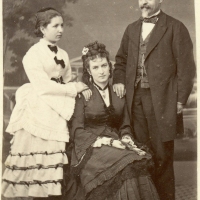
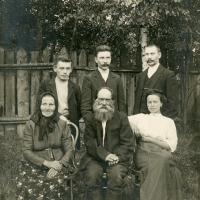
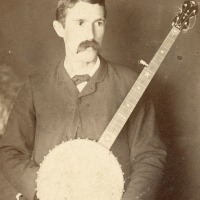
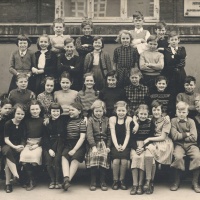
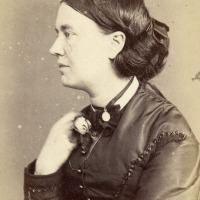
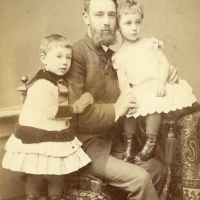
What a wonderful share! I’m positively delighted by Miss Birkin and her being a chevener! I didn’t even know there was such a talent. Her occupation makes me look at everything in the photo with wonderment at how many hands crafted to make it all possible from her lovely shawl to the rocker she sits in. I’m happy to think she had such a fine comfortable spot to while away her stitching hours. I’m quite inspired! 😊
LikeLiked by 2 people
That chair does look comfortable, doesn’t it? It may well have been hers, and not Mr. Moore’s. The only argument I can think of against this being Miss Birkin is that Hastings is a long way from Nottingham. If the photo had been taken closer to her home, that would have supported the identification. It would also have increased the likelihood that the chair was her own. But she could certainly have brought a favorite chair with her on holiday. 🙂
LikeLiked by 2 people
Wow, chevening for 72 years, impressive. And thanks for answering all of my questions about The Queen’s Socks.
LikeLiked by 2 people
Glad to be of service, Stephen. 😉
LikeLiked by 1 person
Thanks for an interesting post! You have a great eye in spotting the woman in another photo! I wonder if her family was from the village of Birkin in North Yorkshire, about 75 miles north of Ruddington?
LikeLiked by 2 people
Thank you, Shayne! I hadn’t heard of that village before your comment. According to Wikipedia, in the Domesday Book the name of the village was “Birchinge,” from birch (tree). I wonder what other obscure information we’re going to learn today. 😉
LikeLiked by 2 people
Trying to discover the origin of this interesting word – chevener – which I could not find in either French or Italian so obsolete has the word become, I came across a photo of Ann Birkin in the very Royal Collections Trust of which you make mention………..Ann Birkin at her embroidery.
https://www.rct.uk/collection/2907541/ann-birkin-b-1816-hosiery-embroideress
Queen Victoria acquired this photo. This pleases me no end because, in the course of trying to track down the root of Ann Birkin’s profession, I came upon a number of recent articles on the BBC website and elsewhere about the very stockings that Ann Birkin embroidered: the white ones. But no mention of anyone but the Queen.
As to what is at her waist, I have a feeling that might be her scissors encased in a thin box of metal. Her embroidery was so fine that her scissors were probably sharp and fine, too. And personal and kept in metal for protection and to avoid stabbing herself when she moved about. Perhaps?
As to what she is carrying: is it possible that, being part of the embroiderer’s tool kit, we might imagine that she is carrying that kit doubled up?
Lay it flat, flat side on the table, it does seem that the half orb that she is holding is actually a pin/needle cushion when turned so that its flat side is lying flat on the table.
Lying on the other side, topside in this photo, is a ball. I imagine that that is a darning egg. Small because she is working on the lightest fabric and small areas of the foot and leg of the stocking with very fine thread.. Used by her for embroidering as opposed to darning but darning also in the event of a small tear in her fabric.
That little egg is sitting on a flat surface where needles are possibly embedded in a small rectangle of fabric which we cannot see.
Perhaps, then, all in all her embroidery tools without the stocking itself which appears in the photo I have attached.
Perhaps?
This remembrance gladdens my heart because she is salt of the earth British: an ‘ordinary’ and extraordinary woman executing her craft to perfection. Like so many millions of others to this day to have created a great nation.
Thank you for this!
LikeLiked by 2 people
Such kind and helpful comments, Sarah! Your description of the embroiderer’s toolkit makes perfect sense. There seems to be a pin visible in the cushion, just above her thumb. I wondered about that little white ball on top! And the needles would be embedded in fabric, out of sight. A compact little kit! I wonder if it was one she used only when traveling, or if she used it all the time at home. (I only wonder because Hastings is far from Nottingham.) I haven’t seen any of Ann’s handiwork, but I’d like to.
The photo you found was the same one I used to identify Ann. So far I haven’t found any others. She’s wearing a different shawl in it. And those stockings! I wonder if that photo might actually have been a royal commission. I say this because Queen Victoria also owned a photo of “John Meakin, Hosiery Weaver,” taken at the same studio at the same time as Ann’s (June 1898). I haven’t researched Mr. Meakin, but he has a kindly face: https://www.rct.uk/collection/search#/2/collection/2907540/john-meakin-b-1816-hosiery-weaver.
Don’t you think the queen was curious about her, about this woman who had done fine work for her from the beginning of her reign? I bet she was curious, but protocol may have kept them from meeting. (I don’t know about such things.)
So glad you enjoyed the post!
LikeLiked by 2 people
When you say you have not seen any of Ann’s handiwork, I take it you mean in the flesh, as it were?
Here is a photo. Unbelievably fine work.
https://www.bbc.com/news/uk-england-tyne-37013567
I think that both photos – John Meakin and Ann Birkin – were either commissioned by the Queen or requested by her and that the collection has many other such of people who served her needs………All so interesting!
Sarah
LikeLiked by 2 people
I hadn’t seen that article, thank you! I didn’t really search for the stockings online, and had only come across one pair, which sold at auction in 2011 for £5,250. Unfortunately, you can’t see much detail in the auction photo: https://auctions.lyonandturnbull.com/asp/fullcatalogue.asp?salelot=338++++++409+&refno=145862&image=0.
LikeLiked by 2 people
Oh, and this pair of black and cream silk stockings in the same auction: https://auctions.lyonandturnbull.com/asp/fullcatalogue.asp?salelot=338++++++410+&refno=++145864.
LikeLiked by 2 people
Would my teachers have words with me or not? Yes, they would with a sentence I wrote above……….
As to what she is carrying: is it possible that, being part of the embroiderer’s tool kit, we might……
We are not part of the embroider’s tool kit, they would say.
I would rather be, I would respond, than be here with you with this horrid grammar lesson……….!
Sarah
LikeLiked by 1 person
This exchange with your imaginary tormentor made me smile. 🙂
LikeLiked by 1 person
Imaginary? ‘They’ tormented me all the years I was at school!
LikeLike
I’m sorry to hear that! 😀
LikeLiked by 1 person
Clocks…….
An explanation (although I prefer the dandelion explanation given by Shoreacres!)
Makers of early machine-knitted hosiery faced a technical difficulty: The foot and the leg, usually made separately, required an obvious and unsightly seam when joined. Stocking-makers would cleverly disguise this seam by embroidering over and around it, thereby turning a “defect” into an attractive embellishment. During the 16th and 17th centuries, clock faces were the most popular motifs for this purpose, so much that so even when a different motif was used to hide the seam, such as flowers or fans, it was still called a clock.
from this Ravelry.com website
https://www.ravelry.com/patterns/library/embroidered-stockings
Sarah
LikeLiked by 1 person
Aha, very interesting! I’m curious why clock faces were such a popular motif in “the 16th and 17th centuries,” as Joan McGowan-Michael writes. You seem to have found the explanation for the use of the word, at any rate.
LikeLiked by 1 person
Clocks……….I wondered why clocks, too………but that undoubtedly has to do with the evolution of clocks themselves and the fashion for clocks among the bourgeoisie et al. when they came into widespread use perhaps in the early industrial age.
That history, of course, is much longer and more complex than that of embroidered hosiery and so I thought I had better not start now on their research because it will be weeks and I will still be scrabbling in the reeds of thatt history!!
As to the word ‘cheviner’, I am wondering if it is related to the word ‘chevron’ which itself has a (French) history in, among other things, the need for a seam.
These stockings were, of course, made in two pieces and the embroidery originally was to camouflage the seams.
But who knows now because ‘cheviner’ is obsolete now……..All so interesting!……Sarah
LikeLiked by 2 people
Yes, at some point you have to say “enough.” The history and symbolism of clocks can wait for another day!
LikeLiked by 2 people
What a fascinating find! The resemblance is striking. If the woman in your photo is not Ann, then she might be a close relative. The attention to detail in all sorts of crafts was astounding before machines replaced workers.
LikeLiked by 2 people
Thank you, Morgaine! I found this story fascinating as well, despite knowing nothing about the craft of embroidery. It’s a human story, about someone doing fine work, at home in her cottage, for more than seventy years. It’s nice to know that she received some recognition for her work.
LikeLiked by 2 people
Old history is exciting! 🙂
LikeLiked by 1 person
Thank you, Annica! 😀
LikeLiked by 1 person
Yes, she looks like the Queen’s chevener. Such detail for stockings that would not be seen! Fascinating post!
LikeLiked by 2 people
Thank you! I wonder how many people would actually have seen the stockings during the Queen’s lifetime? Victoria’s children and attendants would have seen them, but no one else, probably. Glad you enjoyed the post!
LikeLiked by 1 person
Wow! Ms Birkin, what a resume! And what a great discovery you made! I loved the part about the queen’s stockings, as well.
LikeLiked by 2 people
Thank you! It turned into a rather long post, but I hoped readers would find it as (oddly) fascinating as I did. 🙂
LikeLiked by 2 people
Several interesting things caught my attention, not the least of which was the profession of chevener itself. I’d never heard the term, but after a little thought I realized how important those “specialty occupations” would have been.
I’m sure that little pouch held her scissors. My mother did fine work, and she and all her friends had what are called embroidery scissors. The handles of hers were shaped like storks or other birds. I still have them, and found they’re all about 3-1/2″ long, with long, very slender blades for getting into tiny corners and trimming tiny threads. Here are some antique British examples.
Another thing I noticed was the statement that ‘chevener’ “is used in Nottingham to designate the women who ornament the stockings with silk clocks and other kinds of embroidery.” You might wonder if they were embroidered Big Ben and such onto silk stockings! Probably not — ‘clock’ also is used in Britain as a term for the head of a gone-to-seed dandelion, so it may be that “ornamenting the stockings with silk clocks” actually means ornamenting them with flowers.
LikeLiked by 3 people
I’ve seen those little scissors with stork handles! My grandmother had at least one pair, but I didn’t know exactly what they might have been used for.
So that’s what the writer meant by “clocks”! I confess to being mystified by the word. Your explanation makes perfect sense. Flowers are often round like a clock, with petals evenly spaced like numbers. Some open during the day and close at night, like clockwork. Thank you for clearing up that mystery!
LikeLiked by 1 person
This was all fascinating, from her length of employment, to details about the Queen’s stockings, and her kindly face in the photograph. Lovely read.
LikeLiked by 2 people
Thanks so much, Tracey! I wasn’t sure how interested people would be in Victorian stockings, but readers seem to have genuinely enjoyed the post.
LikeLiked by 1 person
Well I never knew what a chevener was! 🙂
Such a great post and well done on finding the similar photo so you could identify this lady. 🙂
LikeLiked by 2 people
Finding the other photo was mostly luck. And don’t worry, no one else knew what a chevener was, either! 😉
LikeLiked by 2 people
haha 😀
LikeLiked by 1 person
Fascinating, all the way around!
LikeLiked by 1 person
A lovely photo, and what an interesting story! I hadn’t heard of cheveners before. I remember though from my readings about Henry VIII that his queens employed ‘silk women’ who would do embroidery and braiding in silk for the queen’s clothes. They also worked in their own homes, like Queen Victoria’s stocking embroiderers. I think in the novel ‘Wolf Hall’ Thomas Cromwell’s wife is a silk woman.
LikeLiked by 2 people
That really puts Ann’s story in historical perspective, doesn’t it? She was part of a very long tradition. If the articles I quoted are correct, she retired in 1901. Victoria died on January 22 of that year. Ann was described in the Greenock Telegraph article, on February 27, as “in the employment of Messrs Morley for seventy-two years.” The second article also puts her career with the firm at 72 years. I think it could reasonably be called the end of an era.
LikeLiked by 1 person
Wow, Brad – that’s amazing to have found who the woman was. Well done! The item she’s holding looks to me like an opened-out wallet, but I suspect as others have said it’s probably to do with her work – maybe something to hold the tools of her trade… I’d guess a needle-holder. My sister,when she was a child, made a foldable ‘book’ out felt in which our mother used to keep her needles – I still have it. If it were folded outward it would look like part of the one in the photo above, though it’s only got one fold.
LikeLiked by 2 people
I’d never heard of a chevener before, either. The links to the stockings in the comments show some exquisite work.
You and your readers are amazing researchers!
LikeLiked by 2 people
Thanks so much, Ruth! I love it when my readers make discoveries! I’m sure every photo has remarkable stories to tell. It’s just that most are too well hidden, even for expert sleuths such as ourselves. 😉
LikeLiked by 1 person
chevener… thanks for sending me down this wonderful rabbit hole!
LikeLiked by 1 person
Thanks for reading! Not everyone appreciates being sent down a rabbit hole. 😉
Can’t wait for Part II of “His Name was Bond”!
LikeLike
Lots of new vocabulary in this one! In merriam webster online there’s a definition of clock as “an ornamental figure on the ankle or side of a stocking or sock”.
I like the previous commenter’s connection between this expression and the heads or blooms of flowers. I wonder if the expression “to clock someone” (as in punch in the face) has a similar history.
You could do Victoria-related ephemera all day long and I wouldn’t complain. In bbc’s Victoria, Prince Albert always plays the the champion of the Future, with a capital “F.”
I think we are going through a revolution as profound as the industrial one and could do well to learn from their example. What is the independent contractor and “gig” economy, after al, but a return (for better or worse) to “cottage industry?”
LikeLiked by 2 people
Great points, Andrea! I agree that computers have changed our world in fundamental ways, on a scale comparable to the industrial revolution. Industrial production made material goods available to everyone, while computers have made information available. Technological change is a subject you’ve mentioned before, so I know it’s of interest to you. I need to watch “Victoria”!
LikeLiked by 2 people
Très intéressante cette recherche 🙂 Concernant l’étui que l’on voit à sa taille , je pense que c’est peut-être un étui qui contenait ciseaux , aiguilles etc..
Merci pour le partage de votre passion ou hobby 😉
Belle fin de semaine .
LikeLiked by 1 person
You must be right! It makes perfect sense. Surprisingly, this post is the most popular one on the blog. Visitors come here from search engines almost every day. I don’t know what exactly they’re searching for.
Merci beaucoup, Pierrette! Enjoy the last week of October!
LikeLike
On ‘chevener’ which was often spelled, in the Censuses, ‘cheviner’. I wonder if there is any connection with the rocky feature overlooking Otley in Yorkshire known as The Chevin? No-one has conclusively shown what the etymology of that word was but one possibility is the Celtic word ‘cefn’ meaning a ridge (in Yorkshire several prominent hill features have retained their original Celtic names). And chevening a pair of stockings would, no matter how fine the work was, have created a discernible ridge in the stocking surface.
Another connection that may be worth looking into is that of the prestigious Chevening Scholarships offered by the British Government and named after the stately home of that name outside Sevenoaks. How did it get this name? And isn’t it rather nice that the lucky people given such scholarships are called ‘cheveners’ like Ann Birkin? Ornamenting their knowledge….
LikeLiked by 1 person
Very interesting comments, Richard. I hadn’t heard of Chevening House or the scholarship program named after it. I knew something of the Stanhope family and was glad to learn more.
I don’t know if you looked for more information online about Ann Birkin, but this photo of her was used for a banner created at the Framework Knitters’ Museum in Ruddington: Ruddington’s Jubilee Banner. The museum might have some theories about the origin of the word ‘chevener’.
LikeLike